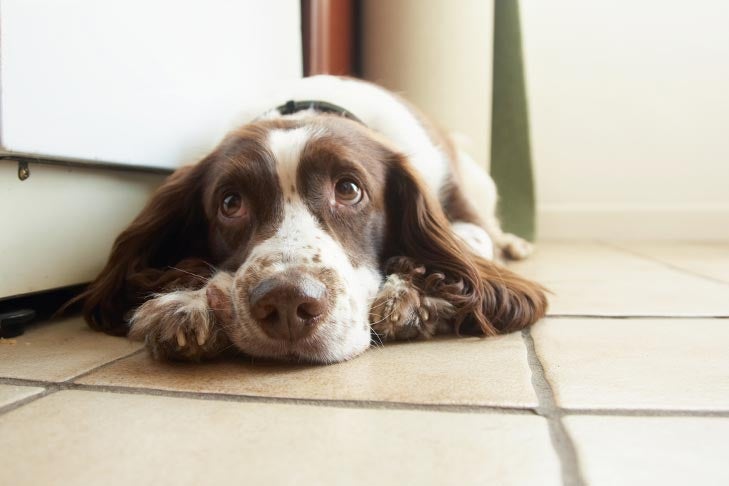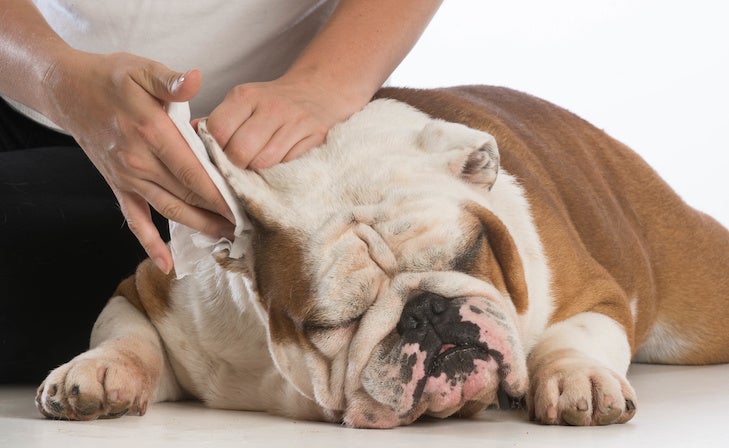AKC is a participant in affiliate advertising programs designed to provide a means for sites to earn advertising fees by advertising and linking to akc.org. If you purchase a product through this article, we may receive a portion of the sale.
Hot spots are one of the most common skin conditions in dogs, particularly in the summer months. These painful, oozing sores can appear seemingly out of nowhere and often spread rapidly. While they are frustrating to deal with, this common condition can be aided by hot spot treatments, and even prevented with the right management of your dog’s skin and coat.
What Are Hot Spots on Dogs?
Also known as acute moist dermatitis, hot spots in dogs are localized areas of skin inflammation and bacterial infection. Often a hot spot on a dog will begin as a small red area on the skin that owners may mistake for an insect bite. Unlike an insect bite, a hot spot on your dog will rapidly worsen and spread, developing into a hot, red, oozing, and painful lesion.
What Causes Hot Spots on Dogs?
Hot spots on dogs are often triggered by scratching, licking, or chewing the affected area of skin. The resulting trauma to the dog’s skin causes inflammation and secondary bacterial infections. Unfortunately, this self-trauma only makes the area more irritated and itchier, which causes a self-perpetuating cycle of itching and scratching. Thus, any condition that causes your dog to feel itchy has the potential to result in a hot spot. Common causes of the itching/scratching cycle in dogs include:
- Parasites in dogs
- Flea allergy dermatitis
- Dog food allergies
- Atopic dermatitis
- Ear or skin infections
- Anal sac disease
- Contact irritants
- Stress or boredom resulting in excessive licking
- Coat that is dirty or matted
- Moisture trapped in the coat from swimming or bathing
Many of these conditions are chronic problems in dogs that can lead to recurring hot spots if they are not appropriately managed. Identifying and addressing the underlying cause of your dog’s hot spot is one of the most important factors in preventing future skin problems.
Some breeds such as Golden Retrievers, St. Bernards, German Shepherd Dogs, Labrador Retrievers, and Rottweilers are predisposed to developing hot spots due to their thicker coats. Hot spots are also more likely to occur during warm weather and periods of high humidity. Dogs that are frequently wet from swimming, bathing, or inclement weather are more prone to developing hot spots due to the excess moisture held against the skin by their coats.

Symptoms of Hot Spots in Dogs
Many skin conditions have similar symptoms to hot spots, so it is important to consult your veterinarian if you are concerned about your dog and think they may have a hot spot that needs treatment. Hot spots are typically well-defined areas of redness, swelling, and hair loss. They can occur anywhere on a dog’s body, but are most commonly seen on the head, limbs, and hips. The affected area is moist and may discharge pus or fluid, which can lead to crusting and matting of the surrounding fur or hair. Hot spots on dogs are painful and very itchy, and will rapidly grow as the dog’s scratching continues to traumatize the area.
Treatment for Hot Spots in Dogs
If you suspect your dog may have a hot spot, the first step is to consult your veterinarian. While it may be tempting to wait for your dog’s hot spot to resolve on its own, delaying treatment will only make the problem worse. In order to treat a hot spot effectively and prevent it from recurring, your veterinarian will need to determine the underlying cause of the irritation. They will perform a full physical examination on your dog, and may recommend additional diagnostic testing, like a skin scrape, to look for parasites. Once the underlying cause of your dog’s itching has been diagnosed, your veterinarian will explain the best treatment to help resolve your dog’s hot spot.
Treatment for hot spots in dogs typically involves some combination of the following:
- Clipping the hair around the area to prevent further matting
- Cleaning the affected area with gentle antiseptic cleansers such as chlorhexidine
- Bathing with a chlorhexidine shampoo for dogs
- Prescribing topical or oral antibiotics to treat secondary bacterial infections
- Prescribing topical or oral steroids to control inflammation and decrease itching
- Prescribing allergy medications for dogs that stop the underlying cause of itching
- Using medicated dog wipes or solutions to gently clean the area daily
- Under supervision, wearing a dog cone (also known as an Elizabethan or “E” collar, or dog recovery collar) can stop access to the hot spot to temporarily distract your dog from continued scratching, or a dog recovery suit can cover an area of the body if your dog is known to outsmart a cone
Fortunately, once your veterinarian has initiated treatment for the hot spot on your dog, most dogs improve rapidly. In many cases, the hot spot resolves in as little as three to seven days after the start of treatment.

Preventing Hot Spots in Dogs
The best way to prevent additional hot spots from occurring is to identify and address the underlying cause of your dog’s itching. Good parasite prevention for dogs, treatment of skin infections, and management of allergies are essential to prevent dogs from starting to scratch and, as a result, prevent trauma to the skin. Good hygiene and routine dog grooming can also help. For dogs that swim or are frequently bathed, it is also important to ensure their coats are thoroughly dry after each session.
If your dog is licking due to stress or boredom, increasing daily exercise and engaging in active play time can help your dog use up that excess energy. Using brain games and enrichment like puzzle toys or slow-feed bowls is a great way to keep dogs mentally stimulated, even if you can’t be there to play with them. Your dog will love the additional activity and will be healthier too.
Supplementing fatty acids is another option to prevent and manage skin disease in dogs. The critical omega-3 fatty acids DHA and EPA are found in fish oil for dogs. These fatty acids not only have anti-inflammatory properties, but they also help promote a healthy skin barrier, making your dog less susceptible to allergens and infection. A small amount of topical aloe vera gel directly from an aloe vera plant can help soothe damaged skin and decrease itching on your dog’s skin, but don’t use a commercial aloe vera gel made for your human skin on your dog. You can find soothing aloe vera skin spray for dogs that’s formulated to be safe if they should lick it.
Hot spots are an itchy and painful problem for your dog and may become a recurring issue if the underlying condition isn’t treated. Fortunately, with good management, your dog’s hot spot should resolve quickly and will not result in any permanent damage.

